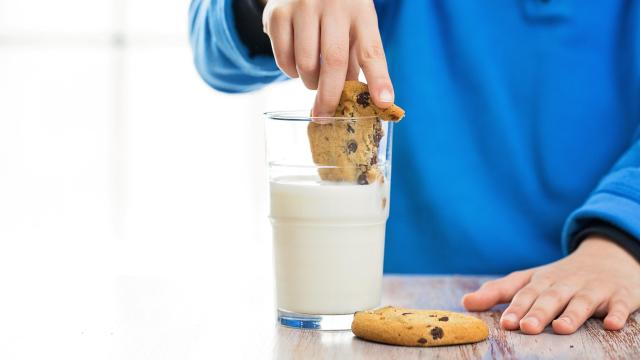When Greek NBA player Giannis Antetokounmpo tried dipping his Oreos in milk a few months ago for the first time, his mind was understandably blown. “From now on, that’s an every night snack for me,” he said during a press conference. (Watch the clip below. It is delightful.)
Dunking is such a big part of snacking, it has its own Wikipedia page. Ancient Romans dipped hard, unleavened wafers into wine, Proust famously wrote about a dipped madeleine, and modern Australians participate in a snacking ritual called the “Tim Tam Slam” or “tea sucking.” Brits are obsessed with tea-soaked biscuits, and the United States is home to a chain of doughnut shops with “Dunkin’” right in the name. It’s a practice so imbued into snacking culture, we don’t question it — but there are plenty of practical and scientific reasons for dunking.
First, there is softening. The aforementioned unleavened Roman wafers were quite hard on the teeth, and dunking them in wine made them easier to chew (and it made them taste like wine, which I am guessing was an improvement). Dunking also softens Oreos and other British-style biscuits, letting eaters experience an alternate texture than what they experience eating a cookie fresh from the package.
Flavour-wise, dunking serves two functions: flavour-smoothing and flavour-accentuating. If you’re dunking a cookie in milk, you’re smoothing out the harsher, more cloying qualities of the baked good. In 2016, Matthew Hartings, a professor of chemistry at American University, told Quartz that “it’s partially due to the chemical compounds interacting on our tongues.” Milk is full of emulsifiers, which keep the fat from separating out when it’s stored in the fridge. These emulsifiers “help to smooth out the chocolate as you’re eating it,” while the moisture softens the cookie and helps your tastebuds access the flavours more quickly. The fat in the milk also dulls any sharp, or overly sweet flavours. (I’ve also noticed that it dulls the some of the more synthetic flavours in mass-produced, pre-packaged cookies.)
Tea and coffee offer a different experience. We get the same softening effect that we get from milk, without the muting effects of the fat, along with a ton of different, flavorful molecules, some of which can be found both in the beverage and in the cookie. These chemical compounds interact with each other, coating our tongues and wafting into our noses, letting us experience both the snack and the beverage in a new and interesting way. Toasted flavours in coffee and tea complement the toasted flavours in your baked good, while the bitter, more astringent flavours in both beverages temper some of the sweetness and offer contrast. It’s really quite beautiful.
Why doesn’t this work with water or juice? Simply put: The molecules don’t play well together. Water doesn’t give the cookie or cake a lot to work with — there’s nothing to complement or contrast, no emulsifiers, and no fat. You get a soggy cookie, without any of the flavour-smoothing or flavour-contrasting properties offered by milk, tea, or coffee. Juice brings a lot of flavorful molecules, but they are often the wrong molecules, though there are exceptions. I’ve never dunked a graham cracker in apple juice, but they’re pleasant enough when eaten side by side, and I could see fruit-flavored cookies working with corresponding fruit juices. I would never recommend dunking a cookie, or any other baked good in orange juice, however. Orange juice is very ornery.

Leave a Reply
You must be logged in to post a comment.